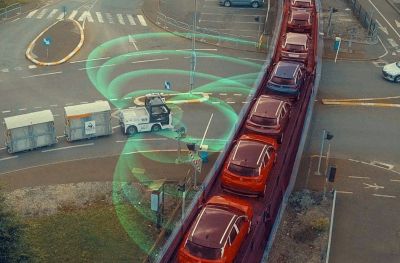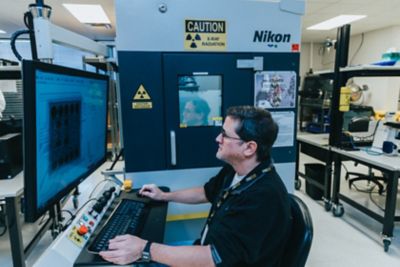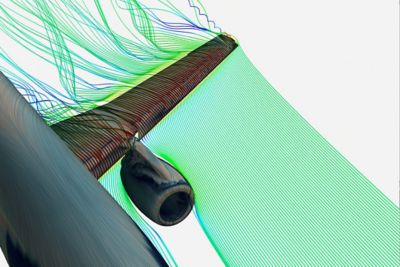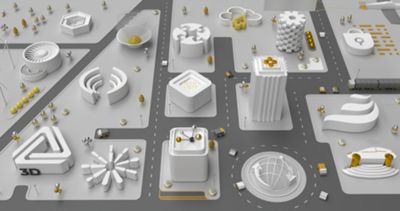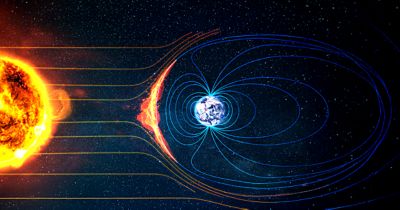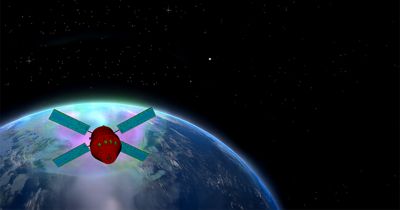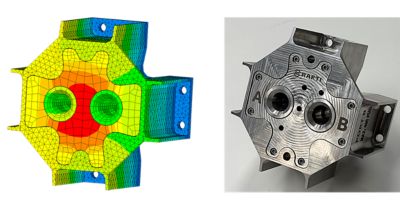How well do we know the Moon? If you were to ask lunar geologists, they’d tell you that we have a lot left to explore, especially in the Moon’s south pole region. The potential for water in this area has drawn the interest of scientists and commercial businesses alike. Water — or water ice — on the Moon could be melted or even separated into hydrogen and oxygen, thereby providing essential resources for astronauts.
However, confirming if there is water ice in this area and locating it if it does exist will not be an easy task. Beyond the already-daunting job of sending machines to the Moon itself, the terrain at the lunar south pole is particularly treacherous. Deep craters cover a great deal of the south pole. Most of them are in constant darkness and incredibly cold, which makes landing, researching, and navigating an arduous task. Increasing this difficulty are the potential moonquakes and faults found in the area.
To address this challenge, new, innovative technologies are needed, and Intuitive Machines is one of the companies stepping up in this area. As part of its mission to provide services that open access to the Moon, Intuitive Machines developed technology, including its Nova-C class lunar lander, which enabled the company to facilitate the first commercial landing on the Moon and the first U.S. Moon landing in over 50 years.
The Intuitive Machines team has also developed the µNova Hopper (a propulsive drone the size of a minifridge), which can be deployed off of the team’s lander. This technology is designed to study the mysterious south pole region of the Moon and search for resources like water ice.
Jason Soloff, the company’s Lunar Data Network chief engineer, explains that the µNova Hopper was created to withstand the harsh conditions of the lunar south pole. The hopper is designed to traverse the deep craters on the Moon’s south pole, autonomously perform its mission while unable to communicate, and then return to a ridge where it can share its knowledge.
Using the next iteration of this technology, engineers and researchers hope to take photos and drill into the regolith of the south pole to study its composition and learn how to search for signs of water. In this way, Intuitive Machines’ work can contribute to wider goals of looking for water and other resources on the Moon.
“If we can drill into the surface and confirm our theories on how much and if there is any water there, then that would be super exciting because that unlocks habitation in a base and even a refueling station,” says Jordan Reynolds, avionics engineer at Intuitive Machines.
Now, the Intuitive Machines team is preparing for its second mission — and that’s not all the company is working on either.

Advancing Lunar Technology
Landing on the Moon’s south pole is only one of the many goals at Intuitive Machines. As Soloff says, “Intuitive Machines is a diversified space company, and we’re working to advance technologies and change the way that the space economy works — opening it up for all humanity.”
For instance, Intuitive Machines aims to make the space economy more sustainable by using a methalox engine for its Nova-C lander. Methalox is a clean fuel made of liquid methane and oxygen. It is also of interest to the space industry due to the possibility of generating this fuel off Earth by using resources found on the Moon and Mars. Reynolds emphasizes that if humanity is able to find water on the Moon’s south pole and use it to make fuel, “that’s the most pivotal and exciting science.” Intuitive Machines is making significant strides with this propellant system, and Soloff shares that its recent IM-1 mission was the first time that a methalox engine has been repeatedly fired in deep space.
As for communications, the company also provides a validated cislunar communications solution, the Lunar Data Network (LDN). The network supports near-space missions through its lunar operations center, globally commissioned dish network, and upcoming lunar data relay satellites. With the expected influx of satellites in the coming years, there will be an increasing need for communications infrastructure in cislunar space — a need that the LDN will help address.
Beyond cislunar space, Intuitive Machines has long- term plans that extend to Mars too. For these projects and technologies to succeed, the Intuitive Machines team needs to rigorously test all its designs and adapt them to the harsh environment of space. To do so, the team relies on Ansys simulation software.
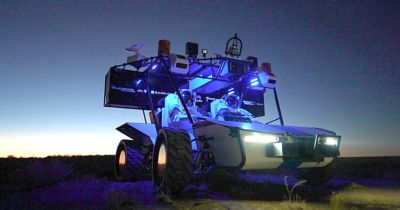
Photo of an Intuitive Machines vehicle. Credit: Intuitive Machines.
Shooting for the Moon with Simulation Software
As a small startup with limited resources and staff, Intuitive Machines has found simulation to be instrumental to its success.
“Simulation for us is a force multiplier,” says Soloff. “It lets us try different ideas … very quickly.” With simulation, Soloff and the rest of his team can more quickly and easily test ways to solve problems, unlocking their creativity. “What-if” scenarios, such as using different landing gear designs or gimbals, can be virtually tested. Then, using the information generated from the simulation analyses, engineers can easily learn how changing these variables affects important facets of their design, like overall stresses, loads, and thermal performance.
As for when the Intuitive Machines team uses simulation, Reynolds says it uses Ansys simulation software to perform necessary analyses and tests throughout the entire mission. For example, take the initial design stage. Here, Soloff emphasizes how reducing mass is important for space technology. Other requirements include ensuring that machines can survive the forces of launch, as well as the extreme heat and cold experienced during the mission, when the craft has the Sun hitting one side and extreme cold on the shadowed side of the lander. With simulation, the team was able to optimize for all these requirements. “Our analysis helps us design, thermally and powerwise, systems that can withstand extreme changes in temperature,” says Reynolds.
To perform these calculations, Intuitive Machines relied on Ansys Systems Tool Kit (STK) digital mission engineering software. One way that the company used this software was to model solar rays and determine when they would hit the lander and hopper and when no light would reach the machines. This is important knowledge that would be difficult to recreate by physically testing on Earth. Further, with simulation, the Intuitive Machines team can perform thermal analyses and see how heat moves through complex materials, a task that is very time-consuming to do by hand. In fact, “I’d say it’s almost impossible on the type of timelines that we have,” says Soloff. “So, we rely very heavily on the analysis of simulation tools, and the Ansys suite has been fantastic for that.”
Part of the reason why Ansys simulation software is so useful to the team is because of its multiphysics capabilities. Intuitive Machines is working on “incredibly complex multiphysics problems that aren’t just an antenna pattern or a structural analysis of vibration or shock,” says Soloff. “It’s about integrating all these disciplines together through an integrated set of model and simulation tools that let us do what we need to do.”

Intuitive Machines in space. Credit: Intuitive Machines.
Ensuring that its communications systems are functional and optimized is another key use of simulation for the team. Here, Intuitive Machines relied on Ansys simulation for everything from ensuring that antennas are oriented correctly to comparing the throughput and bandwidth generated by different ground stations and radios.
To perform these communications analyses, the team once again turned to STK software to, among other things, analyze how strong its communications are, how much data it can move, the predicted signal noise, the signal strength, and more. Soloff shares how simulation software and modeling truly aid in performing complex electromagnetic analyses. For example, the company uses Ansys HFSS high-frequency electromagnetic simulation software and radio-frequency (RF) simulation to analyze and optimize antennas, radiation patterns, and electromagnetic radiation for communications.
These are not the only ways that Intuitive Machines uses simulation to improve its technologies either. Pictures are essential data points for the company, especially photos of the Moon’s south pole. As such, Reynolds says the team focused on using simulation software to ensure that it could successfully collect and transfer that photographic data during the mission. Using its simulations, the team was able to coordinate with communications providers to identify which services would be most ideal for the mission.
“It’s a huge team effort to get something on the Moon,” Reynolds says. “So, being able to use simulation to prepare for a worldwide mission really helps.
“Not only is STK software capable of simultaneously performing a wide range of analyses — it can do so while keeping up with highly dynamic mission conditions,” says Reynolds. “On outer space missions like those Intuitive Machines is performing, conditions such as light, temperatures, speed, radiation patterns, terrain, trajectories, and signal strength can change rapidly. STK software enables engineers to model these changes and account for the whole mission. For example, we used STK’s terrain modeling and communications modeling shortly after landing to understand how the vehicle was orientated in relation to the Earth, Sun, and Moon system after our dynamic landing.”

Simulation analyses showing Earth inertial axes (top) and Moon inertial axes (bottom). Credit: Intuitive Machines.
Throughout all the different areas where it uses simulation software, the Intuitive Machines team finds that an increase in efficiency is a common denominator. Soloff says analyses that could take weeks to perform without simulation take only a matter of days when using Ansys software. This is incredibly important since the team often doesn’t have months to solve problems; instead, it frequently needs to find solutions in just hours or minutes. In cases like these, Intuitive Machines can use validated Ansys models to find answers and make informed decisions quickly. This is even true for notoriously challenging calculations, such as accurately solving the three-body problem of how the Earth, Sun, and Moon all affect the mission.
This speed even translates to making informed real-time decisions during missions. For example, Reynolds is developing a real-time simulation “where we can pipe in the telemetry coming from our lander during the mission, simulate that with the STK software, and start visualizing and gaining situational awareness during the mission,” he says. This is beneficial because it enables the researchers to rapidly understand the mission situation through their models instead of having to contextualize data on a screen. That way, if something unexpected occurs, they can react more quickly.
Of course, speed is useless without accuracy, which is why the Intuitive Machines team has been sure to rely on proven technology. “What we gain with these tools is not just time but confidence in our analysis,” says Soloff. With Ansys simulation software, Intuitive Machines can save time without sacrificing accuracy. This increases efficiency and enables the company to reallocate its efforts and limited resources to other parts of the mission. “We simply could not do what we do without modeling and simulation,” says Soloff.
With simulation, “we can go in, model everything, and have the confidence that we don’t need to spend another year refining our technologies,” says Reynolds. This saves precious time for startups like Intuitive Machines, making it more competitive and mission-ready in a shorter span of time.
The Future of Space
Curiosity about the universe around us is a connecting thread for many people — from a family spending an evening staring up at the stars on a summer’s night to those who make a career in performing leading research in this area.
“Space is the great unknown,” says Reynolds. “Seeing what kind of knowledge we can gather in space about the universe and what humans know and don’t know is really inspiring.” The work that Intuitive Machines does is helping to solve some of these mysteries.
Furthermore, while there are limited resources on Earth, “the solar system is filled with resources,” Soloff says. One of these resources is the very ice that the Intuitive Machines team is looking for signs of on the Moon’s south pole. By locating resources like this, the Intuitive Machines team hopes that its work will aid in finding the resources needed to better explore the mysteries of space.
Learn more about how STK software can help with your space missions.
"Simulation for us is a force multiplier. It lets us try different ideas … very quickly.”
— Jordan Reynolds, Avionics Engineer, Intuitive Machines
